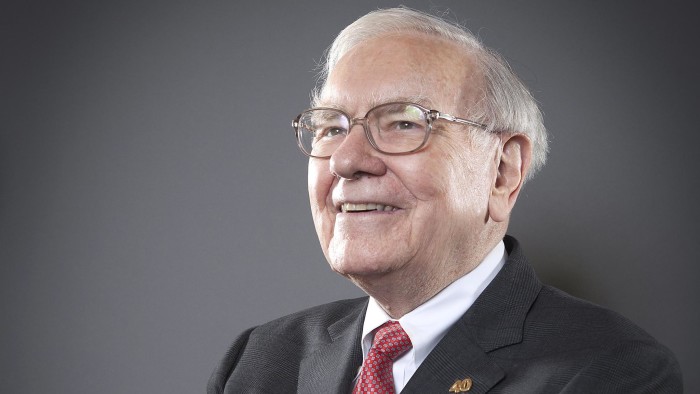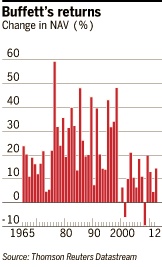How to invest like Warren Buffett

Roula Khalaf, Editor of the FT, selects her favourite stories in this weekly newsletter.
This weekend, legendary investor Warren Buffett will dispatch his annual letter to Berkshire Hathaway shareholders, as he has every year since 1965. Between that year and the end of 2012, the net asset value of Berkshire shares rose by 568,817 per cent, a compounded annual rate of 19.7 per cent with only two down years (2008 and 2001). But how can investors in the UK hope to replicate the Sage of Omaha’s success?
——————————————-
Buy Berkshire shares
It is possible to buy shares in Berkshire Hathaway through most execution-only stockbrokers, just as you would with any other US stock. The trouble is that the A-shares are priced at about $170,000 apiece – meaning a single share would use up nine years worth of Isa allowances.
The B-shares are more affordable at $113 each; they carry proportionately fewer voting rights, but then again shareholder rebellions have hardly been a feature of Berkshire annual meetings.
Stuart Welch, chief executive of TD Direct Investing, said that buying Berkshire shares was no different to any other international stock, although the A-shares would have to be transacted by telephone owing to the amounts involved. Although Berkshire does not generally pay dividends, investors would still be required to complete the US Internal Revenue Service W8-BEN form.
However, detractors have noted that the sheer scale of Berkshire has made it harder to outperform and Mr Buffett himself has noted that size “forges its own anchor”. Returns in the past ten years have ranged between -9 per cent and 21 per cent, a far cry from the 40 per cent returns generated in some years during the 1960s and 1970s.
For those interested in buying the shares directly, Charles Stanley was voted the best broker for international dealing in last year’s FT/IC Investment Awards.
——————————————-
Invest in Buffett-like funds
Many managers claim to follow a Buffett-like investment process, but few have followed that up with Buffett-like returns. Brian Dennehy of FundExpert says M & G’s Recovery fund – which has been criticised for lacklustre returns recently – has a robust investment process and similar long holding periods.
The Fundsmith Equity Fund also prides itself on low portfolio turnover and a stock selection process that prioritises returns on capital over headline earnings. However, it only launched in 2010, so its performance history is brief (though undoubtedly impressive). The ConBrio Sanford DeLand UK Buffettology fund has licensed the term “Buffettology” and modelled its “business perspective investing” on the techniques used by Mr Buffett and other noted value investors such as Walter Schloss, who died in 2012. However, it too has a limited history and is tiny at just £14m.
Among investment trusts, the Finsbury Growth & Income Trust run by Nick Train and Michael Lindsell, runs a high-conviction, value-based portfolio based on big brands, high barriers to entry and good returns on capital. It’s generated compound annual returns of around 15 per cent over the past decade (with two down years) but currently trades on a slight premium to net asset value.
——————————————-
Look for value
If you’re picking your own stocks, a paper examining Buffett’s stock selection and published in December 2013 by Andrea Frazzini, David Kabiller, and Lasse Heje Pedersen is well worth a read.
One of the main conclusions from 45 pages of analysis and formulas was that his stock selection focuses on shares that have low risk and low volatility and companies that have low price-to-book ratios, are profitable, stable, growing and have high payout ratios.
Given the general tendency of value strategies to outperform growth, this should come as no surprise. “Accounting for the general tendency of high-quality, safe and cheap stocks to outperform can explain much of Buffett’s performance, and controlling for these factors makes his alpha statistically insignificant,” the trio wrote. Mr Buffett would be the first to agree: “In investing, it is not necessary to do extraordinary things to achieve extraordinary results,” he told shareholders in 1994.

When it comes to unearthing such undervalued gems, Mr Buffett is disdainful of the creative accounting used by many quoted companies to flatter performance and trigger big share option awards to managers.
“The primary test of managerial economic performance is the achievement of a high earnings rate on equity capital employed, not the achievement of consistent gains in earnings per share,” he wrote to shareholders in 1979. He also places a lot of emphasis on management quality and barriers to entry, famously termed the “economic moat”. Stock screening tools can help identify shares with Buffett-like attributes; a good one can be found at Stockopedia, which is a paid-for site but there’s a free trial.
——————————————-
Use leverage
This might seem an odd thing to say given Buffett’s focus on companies with strong balance sheets and low debts. But access to very low-cost finance has been a crucial component of his success.
Berkshire’s debt is rated AAA – higher than US sovereign debt – so it can borrow very cheaply, while its extensive insurance interests generate a “float” of upfront premium income that can be deployed elsewhere.
Borrowing to invest is not generally considered wise for individual investors to do, but it is a technique widely used by investment trusts and helps explain why they often outperform the equivalent open-ended vehicles.
——————————————-
Be patient
Being very selective about investments inevitably limits their supply, which could result in months of inactivity. Mr Buffett has faced this frustration on many occasions; having excess cash “is a painful condition to be in, but not as painful as doing something stupid,” he once noted.
Simplicity – Buffett’s investment watchword

Interview with Mary Buffett
Once an investment is made, it’s made for the long term. Berkshire first acquired shares in Coca-Cola in 1988; it is still the largest equity holding in the group today. “Our favourite holding period is forever,” he says, because the power of compounded returns is one of the greatest forces in investing. However, the Sage is always willing to admit mistakes, where necessary.
——————————————-
Books on Buffett
Type “Warren Buffett” into the search box on amazon.co.uk and 2,575 results are returned. Using Amazon’s filters doesn’t narrow it down much: there are 676 titles in “investments and securities” and 611 in “personal finance”.
Many of the top sellers were written by Mary Buffett and David Clark. Ms Buffett is not Mr Buffett’s wife but his former daughter-in-law (she was married to his son, Peter, for 12 years). David Clark was an early shareholder in Berkshire Hathaway. More than any others, they have made a business out of “Buffettology”.
However, for those who really want to get under the skin of Mr Buffett’s investing philosophy, there are only two books that matter. One is the collection of his annual letters to shareholders; the ones from 1977 to the present are on the Berkshire Hathaway website, but the full collection from 1965 is available in Kindle format for just £2.07 on Amazon. Ignore all the collections of summaries and highlights and go for the originals, which are full of wit and common sense.
The other recommended read predates Berkshire by several decades; it’s The Intelligent Investor, written in the 1930s by Benjamin Graham, who mentored Mr Buffett early in his career. It provides the intellectual underpinning for Buffett’s value investing techniques, and he himself describes it as “the best book about investing ever written”.
Comments